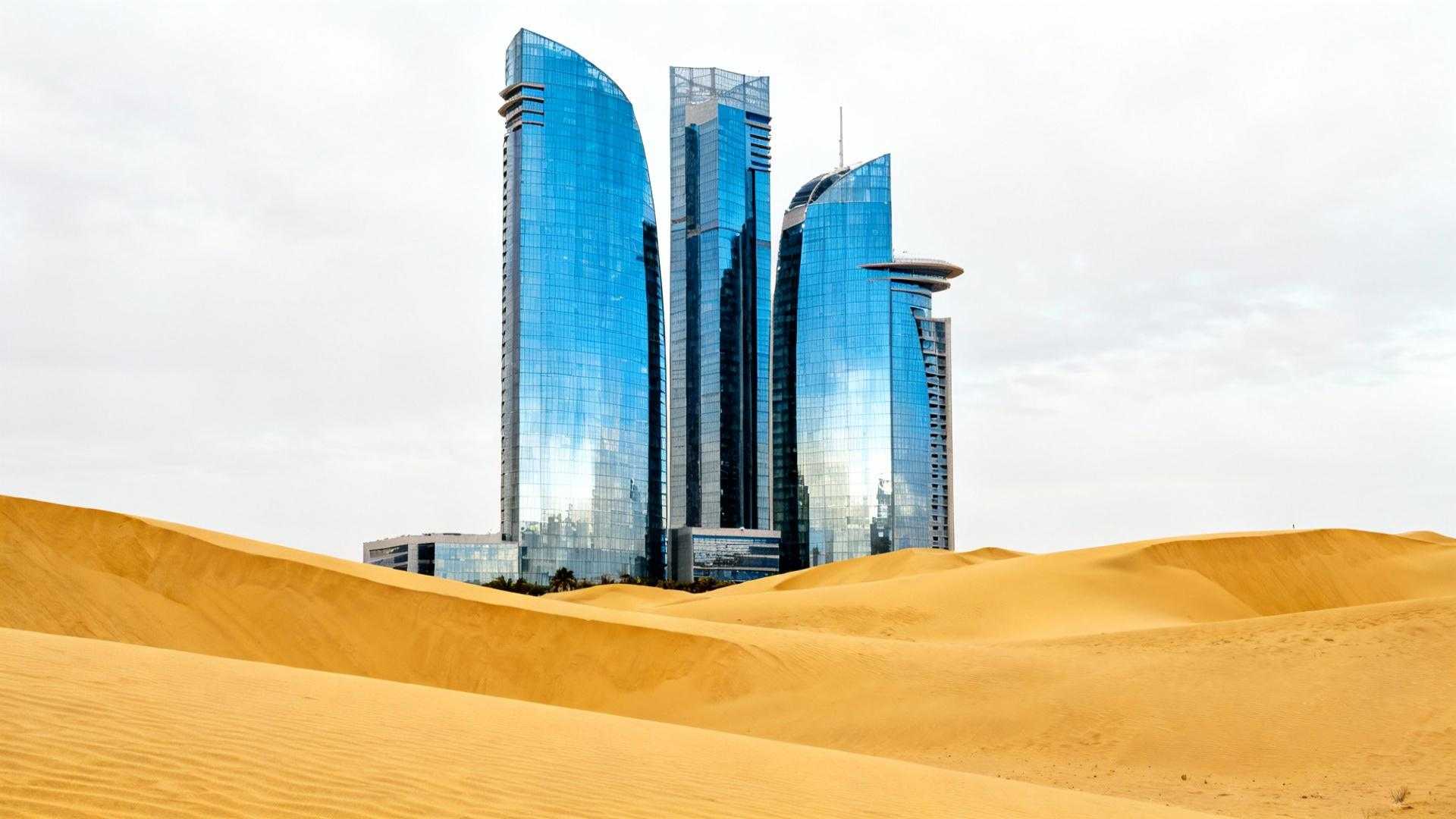Standing at 442 meters above the Arabian Desert, sunset paints the skyline in copper and gold while the vast sand stretches endlessly below. This isn’t a rendering of Manhattan in 2050—it’s Dubai today, where the Burj Khalifa pierces the sky at 828 meters, nearly three times the height of New York’s Empire State Building. The city holds 33 supertall buildings exceeding 300 meters, dwarfing Manhattan’s 17 completed structures in this category. What looks like science fiction costs just $45 for observation deck access, delivering experiences that would command $500 elsewhere at this altitude.
The desert skyline actually surpasses Manhattan’s vertical ambitions through sheer engineering audacity and accessibility. While New York builds upward constrained by bedrock and zoning, Dubai’s towers rise from sand—192 concrete piles driven 50 meters deep anchor the Burj Khalifa alone. The difference becomes visceral at At.mosphere restaurant on the 122nd floor, the world’s highest dining venue, where floor-to-ceiling windows frame 360-degree views impossible in coastal cities hemmed by water and older architecture.
The vertical scale that redefines skyline expectations
Engineering achievements built on desert foundations
The Burj Khalifa’s 828-meter height represents 2.7 times the Empire State Building’s stature, constructed using 330,000 cubic meters of concrete and 39,000 tonnes of steel. Islamic geometric design principles influence the tower’s Y-shaped footprint, maximizing residential views while reducing wind forces—a fusion of cultural heritage and modern engineering that Sheikh Mohammed bin Rashid Al Maktoum envisioned transforming Dubai from fishing village to global metropolis within 50 years.
Altitude experiences at unexpected value
Access to the 555-meter observation deck costs $45, comparable to New York’s One World Observatory at $47 but delivering views from 170 meters higher. The At.mosphere restaurant charges $115 for afternoon tea at 442 meters—an altitude experience commanding triple that price in Western cities. Rooftop bars across Business Bay and Dubai Marina offer panoramic skyline views for $15-30 drink minimums, far below the $50+ charges at inferior heights in Manhattan or London.
Weather certainty that guarantees the view
Desert climate advantage for skyline visibility
Dubai delivers over 300 sunny days annually, with November through March offering perfect 20-26°C temperatures and crystal-clear desert air. Morning heat haze dissolves by noon, revealing razor-sharp tower profiles against cobalt sky. Manhattan’s unpredictable weather—fog, clouds, winter storms—often obscures observation deck views entirely, while Dubai’s arid climate ensures the $45 investment delivers guaranteed visibility.
Optimal viewing windows locals know
The pre-sunset window between 4-6pm captures golden hour transformation as tower glass reflects copper light and the desert glows amber below. Local Emiratis call this period “the sweet spot,” when cooler air sharpens visibility and fewer crowds occupy rooftop venues. Winter months see rooftop bars extend outdoor seating, offering luxury skyline immersion impossible during summer’s 45°C+ heat.
Accessibility that eliminates Manhattan’s obstacles
Metro convenience to doorstep arrival
The Dubai Metro Red Line delivers direct access to Burj Khalifa/Dubai Mall station, eliminating the subway transfers and street navigation plaguing NYC’s observation deck visits. From airport to tower base requires 20 minutes via air-conditioned metro—no security queues, no pedestrian crowding, just seamless urban transit designed around tower accessibility.
Flight costs and booking optimization
Round-trip flights from US cities range $700-1300 for November-March travel, with October bookings capturing 30% savings over last-minute prices. UK travelers find direct flights for £400-700, while Australians access competitive $900-1500 routes. Most Western nationals receive 30-day tourist visas on arrival, streamlining entry compared to complex US visa processes international visitors face for Manhattan experiences.
Cultural depth beyond architectural spectacle
Emirati vision transformed desert into vertical city
The skyline represents Sheikh Mohammed’s deliberate transformation strategy—leveraging architectural innovation similar to Manhattan’s strategic skyline development but compressed into five decades. Local residents protect certain rooftop venues from overtourism, maintaining quiet observation spaces where Arabic coffee and dates accompany skyline contemplation—hospitality rituals absent from commercialized Western observation decks.
Islamic design principles meet modern engineering
The Burj Khalifa’s geometric patterns honor Islamic architectural traditions of vertical aspiration and mathematical precision, while Chicago’s architectural heritage demonstrates how skyline innovation evolved across continents. Rooftop venues incorporate traditional mashrabiya screens filtering harsh sunlight, blending cultural heritage with contemporary luxury in ways Manhattan’s glass towers cannot replicate.
This desert skyline surpasses Manhattan’s through measurable advantages—height, supertall density, weather reliability, and accessible pricing. The 828-meter Burj Khalifa delivers experiences no Western city can match at its altitude, supported by infrastructure designed around visitor access rather than retrofitted onto century-old urban grids. While natural wonders like Mexico’s Copper Canyon surpass famous landmarks through sheer scale, Dubai’s engineered skyline achieves the same revelation—what appears impossible actually exists, accessible, and affordable today.
Essential guidance for skyline experiences
When should I visit for optimal skyline views?
November through March offers ideal 20-26°C temperatures with minimal humidity and guaranteed clear desert air. Book flights by mid-October for 30% savings on peak winter travel. The 4-6pm pre-sunset window delivers golden hour photography and fewer crowds at rooftop venues.
What skyline access costs should I expect?
Burj Khalifa observation deck entry costs $45 for 555-meter altitude access, while At.mosphere restaurant requires $115 minimum for afternoon tea at 442 meters. Rooftop bars across Business Bay charge $15-30 drink minimums for panoramic views without formal reservations.
How does accessibility compare to Manhattan’s observation decks?
Dubai Metro delivers direct station access to Burj Khalifa’s base within 20 minutes from airport, eliminating NYC’s subway transfers and street navigation. Visa-free or e-visa entry for most Western nationals streamlines international access compared to US visa complexities.
